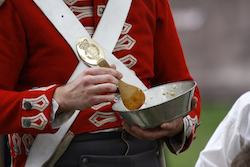|
.jpg)

.jpg)
The 33rd Foot
The 33rd Foot was raised by the Earl of Huntingdon, Colonel George
Hastings in 1702. It was a custom in those days to name the Regiment after its
Colonel to be named Huntingdon’s Regiment. It did not become the 33rd
Foot until 1782 when the title became The 33rd (or 1st
Yorkshire West Riding) Regiment. The Regiments service upto the Napoleonic wars
included : The War of the Spanish Succession (1702-1713), The War of Austrian
Succession (1742-1748), The Seven Years War (1756-1763), The American War of
Independence (1775-1783), Wars in India (1799). In 1794 Arthur Wellesley (Duke
of Wellington) took command. After its return from India in 1812 the Regiment
went out to Germany , in 1813, then onto The Netherlands as part of a force to
attack the fortress of Bergen-Op-Zoom to try to capture Antwerp in 1814.
Napoleon escaped from Elba, The Duke of Wellington was placed in command of
Allied Forces in Belgium of which the 33rd joined part of the 5th
Brigade.
On 16th June 1815 the French attacked them at Quarter Bras of
which the Regiment was heavily involved. Two days later on the 18th
June at Waterloo the Regiment took its part in the final defeat of Napoleon and
at last the war in Europe can to an end.
The 33rd Foot was part of the ‘Infantry of the line’ and wore the
standard uniform of the period : A red jacket but with the relatively rare
facing colour of red (only worn by 53rd & 76th Foot) the
facing colour being the colour of the collar, cuffs). white lace, gold for
officers, grey trousers, white cross belts with brass shoulder belt plate with a
Waterloo Shako introduced in 1812 as their headdress.
The 68th FOOT
The raising of the 68th can be traced back to 1756 as the 2nd
Bt. The Royal Welsh Fusiliers. In 1758 its history as a separate regiment began
being the 20th Line Infantry Regiment to be raised to serve in the
Seven Years War. Its first Colonel James Lambton was a member of one of the
oldest families in County Durham. The first 50 years of the Regiment was spent
on operations attacking ports on the first coat during the summer of 1758, and
then three tours of duty in the West Indies (1764-73, 1794-96, 1801-06), when
they saw fighting in St. Vincent, St. Lucia and Granada. Few died in battle
compared with those who died from disease, over 1500 on their last tour alone.
In 1808 the Regiment underwent a change; they were selected as the third
Regiment to be trained, dressed & to fight as Light Infantry. The need to have a
force of fast moving, lightly-armed troops to strike quickly, fight as
skirmishers was shown during the American War of Independence some 20 years
previous.
The 68th underwent training and was issued with the new clothing,
their jackets had "wings" on their shoulders, a "Belgium" shako with a green
tuft on the front top and a silver metal bugle horn badge. They had lighter
rifles.
During operations they were given commands by the bugle instead of the drum.
A period of service started in 1811 as part of Wellingtons 7th
Division in Spain where they won their battle honours of : Peninsular,
Salamanca, Vittoria, Pyrenees, Nivelle, and Orthez.
nformation provided by D.P.&G Publications
.jpg)
.jpg)
.jpg)
The 68th Regiment of Foot was transformed into a light
infantry
regiment in c. 1808
and was sent to fight in
Wellington's
army in
Portugal and
Spain during the
Napoleonic Wars. The regiment later went on to fight in the
Crimean
War and in
New
Zealand. In 1881,
The Durham Light Infantry was finally formed and soon saw action in
Egypt and against
the
Boers in
South
Africa.
.jpg)
.jpg)
.jpg)
visit DP&G Publications site to purchase
books >> |